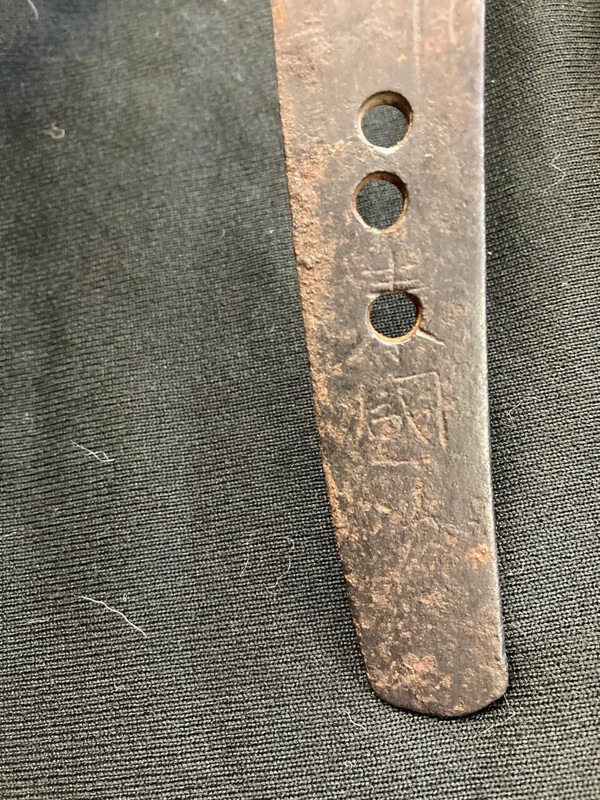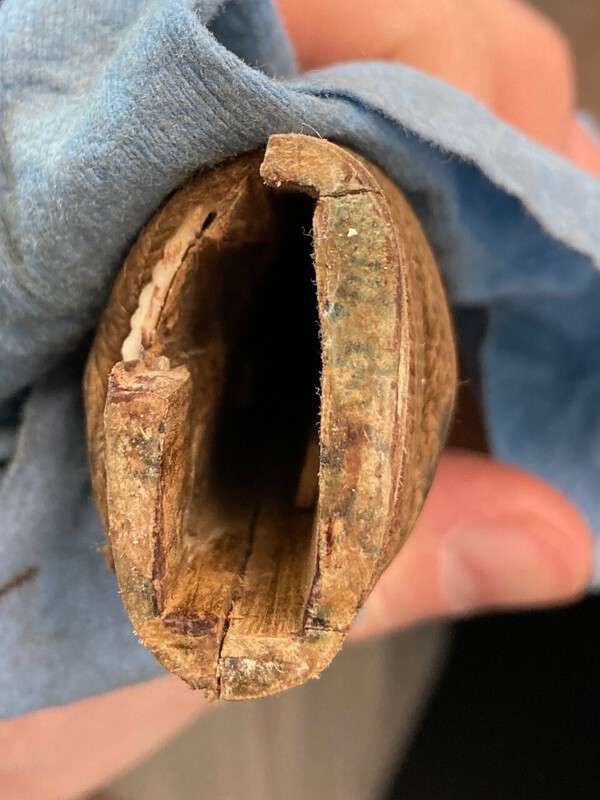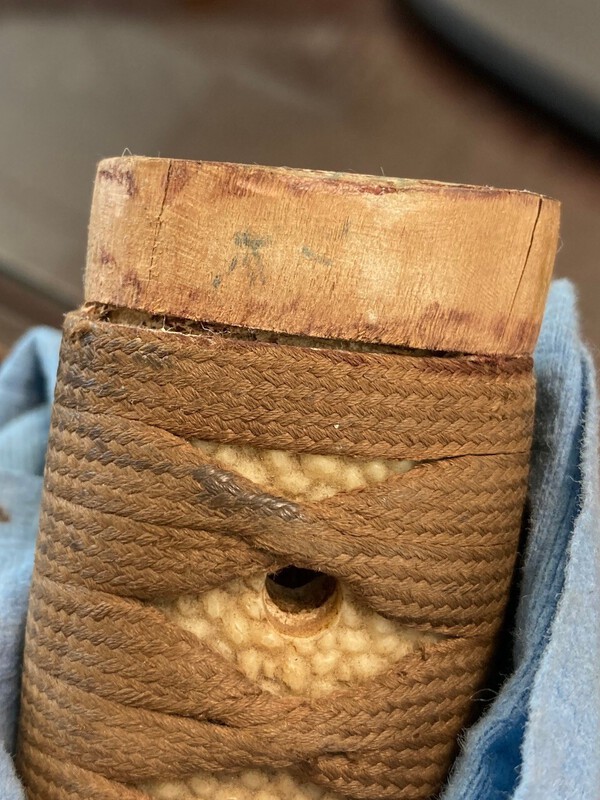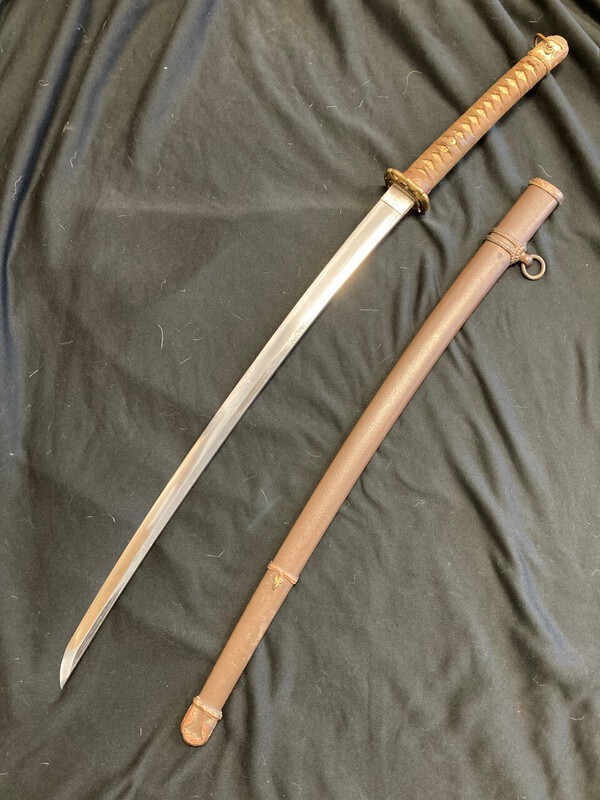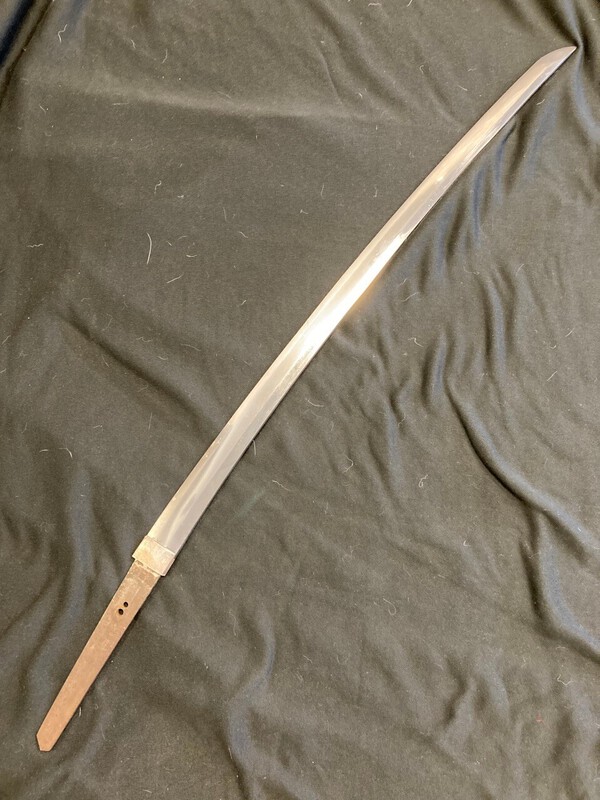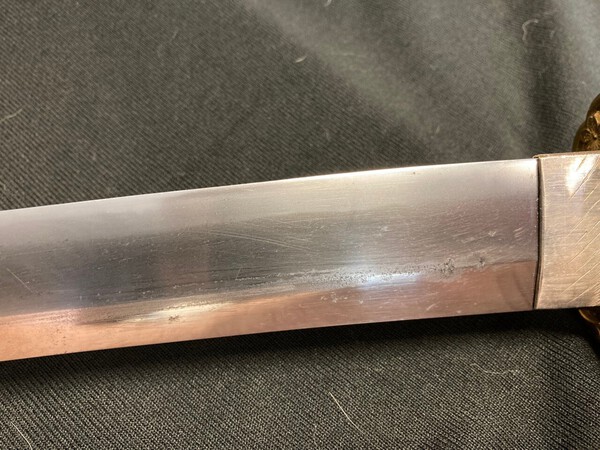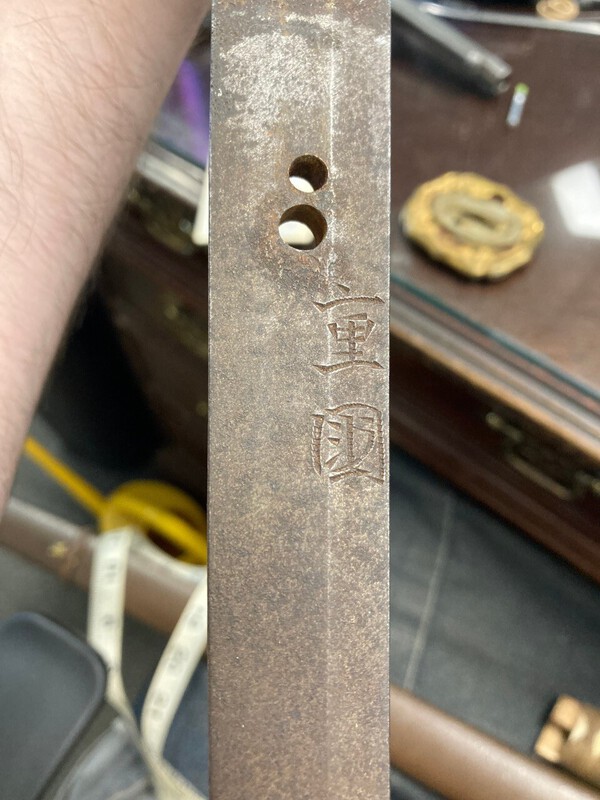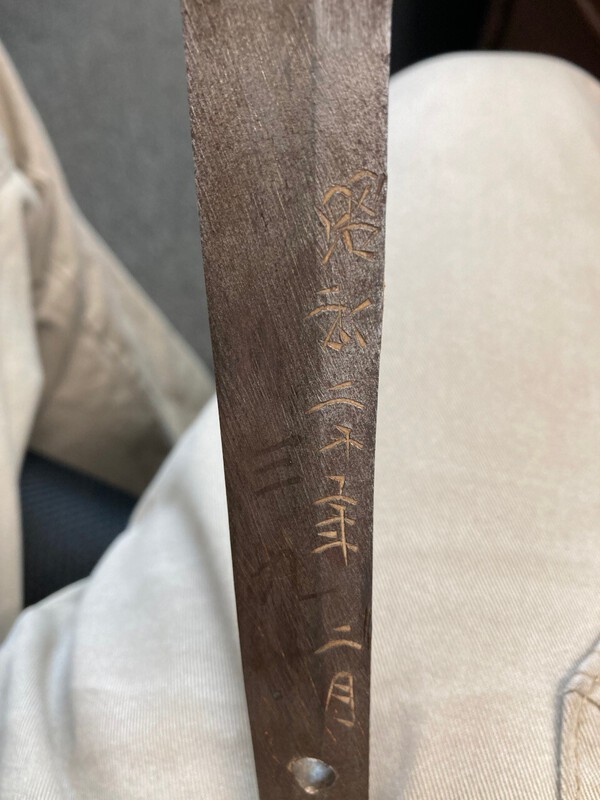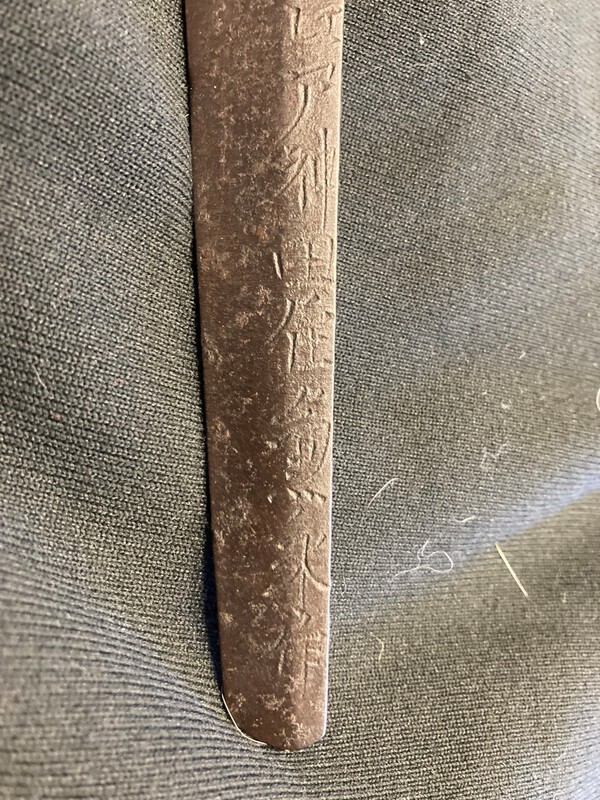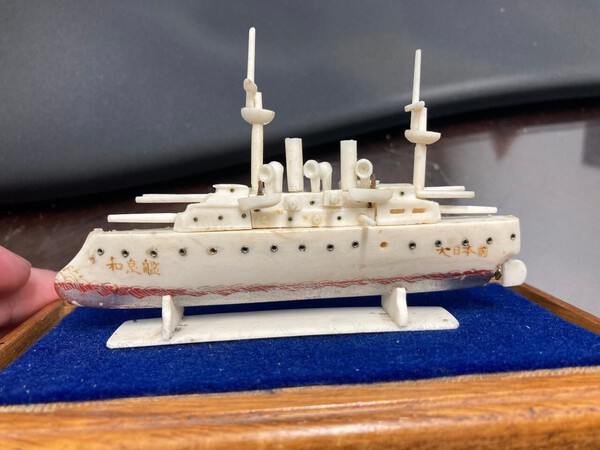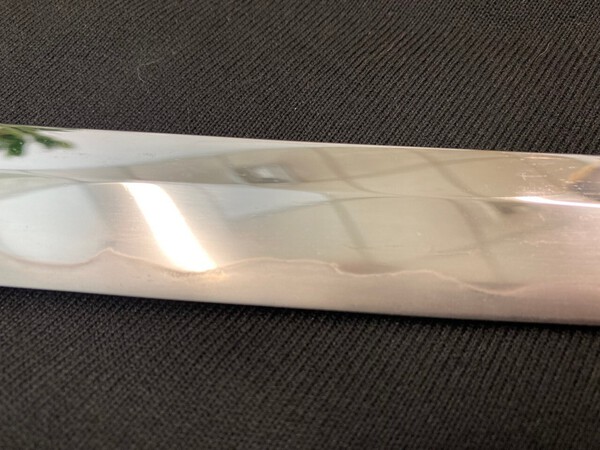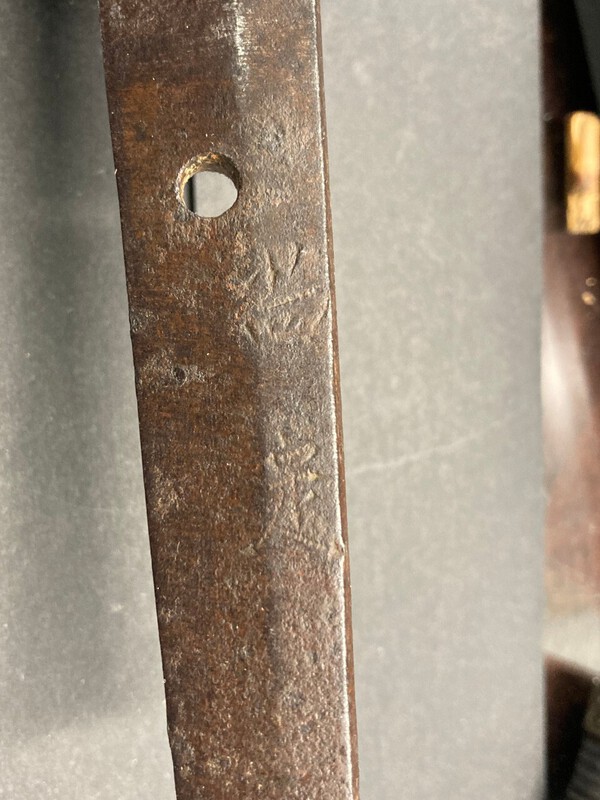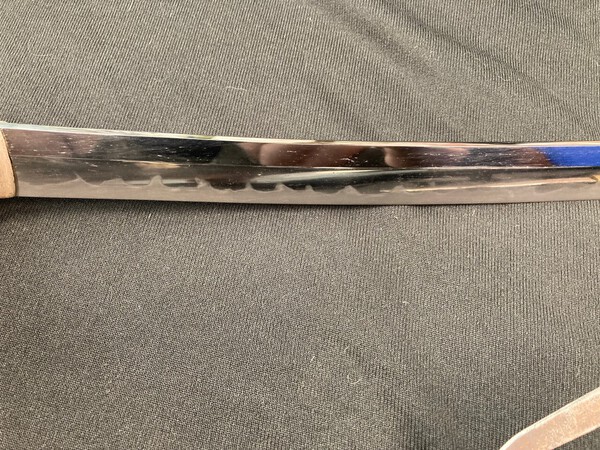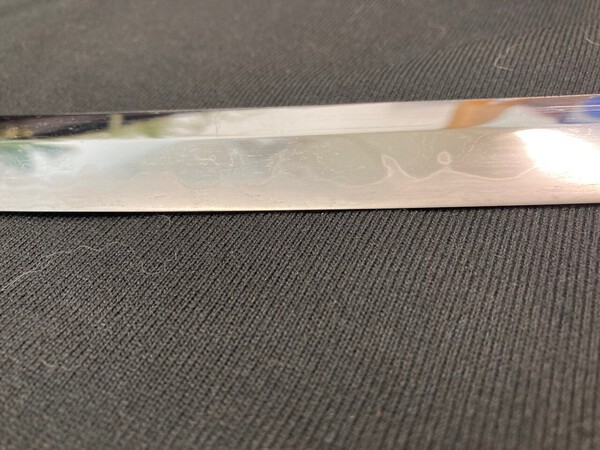
tbonesullivan
Members-
Posts
391 -
Joined
-
Last visited
Content Type
Profiles
Forums
Events
Store
Downloads
Gallery
Everything posted by tbonesullivan
-
I can definitely make out the 國 KUNI in the middle, but this tang is definitely old, and the signature doesn't show the tagane-makura or tagane anymore. Getting pictures of it was "fun", and I had to use some corn starch, which I have been getting better with. The first character looks like 耒 or maybe 秉, but I don't see those usually used in Mei. Unfortunately with the Mekugi-ana right in the middle That's the best I can do. Looking online suggests it might be 来 RAI? It also looks like there is a third character after the Kuni, maybe 次 TSUGU?
-
Unfortunately no information came with the sword regarding when / where it was surrendered. It also has most likely been "messed with" a bit, as it has a bunch of seppa which have matching numbers, however they don't match at all, and more than one has definitely been next to a Habaki for a long time. Overall it's a "regular" type 98, without any mon attached to the handle or any real assembly markings on the fittings or stamped on the tang of the blade. It's got some scuffing so the hamon is not easy to see in some places, and there is definitely some oxidation in a few areas. These are my notes on the blade: 37 ⅞” long with a 26 ⅜” blade. Scabbard 29 ⅜” long HAMON: SUGUHA - 直刃 (straight) NIE Crystals visible. Nioi cloudiness visible. Some Partial Ashi also visible. Hada: MASAME (柾目 Straight)
-
Just wondering if anyone has any information on the swordsmith SHIGEKUNI, which like the KATSUTERU example I looked at, is also pretty much unknown. It's a pretty standard type 98, SUGUHA temper line, Irayagamata tang as with others seen. It has two holes in the tank, one of which looks to be drilled. I also can't quite decide if it is written 重 国 or 重 國, but it looks more like the first one. I did do a search, and came up with this thread from quite a number of years ago, but wondered if there is any more information out there now, compared to 16 years ago.
-
How does the interior of the Habaki fit the blade? I've seen some before where the exterior of the habaki can be a bit off from the interior. It also could be that someone over the years has played the old switcheroo with parts, trying to make one sword better at the expense of another. The screw in the hilt is a bit interesting. Is it brass or steel? RJT Rinji Seikishi usually have a brass bolt / screw in the upper Mekugi-ana.
-
Rinji Seikishi dated 1945 - Signed by KATSUTERU?
tbonesullivan replied to tbonesullivan's topic in Translation Assistance
Well that definitely is interesting. I wonder if the person they had putting the mei on blades that day made a mistake? Or maybe it was a very new smith? -
So, I've searched all my resources, and just wanted to check my reading of the mei, as the best I can tell it reads 勝 照 - KATSU TERU, and no other Kanji even comes close to the second one. I went through just about every Mei beginning with KATSU I could find and was not able to find anything. Consulting my Kanji charts came up with TERU for the second character. I can't find any smith listed under this name. It's signed in the usual late war "chippy" way so I thought maybe I was misreading it. Date is pretty standard 昭 和 二 十 年 二 月 - Showa 20 (1945) 2nd Month (February). The sword is a completely standard arsenal made "P-1944" Rinji Seikishi in every other way aside from the signature I cannot identify.
-
Isn't that the type of Rinji Seikishi used on the RJT swords? The textured lacquered scabbard, "cup" shaped seppa, the lacquered ito and shape of the tsuka. It's definitely not the "run of the mill" "P-1944" which has the tan finished steel scabbard. Those usually go for a lot more than the "P-1944" with the arsenal blades, though that's subject to the condition of the blade, as always.
-
This blade came in Type 98 Mounts, but it's quite long, 28 1/8" or 71.4cm. The Habaki definitely looks to be older than WWII, and the Tang is worn and patinated. I can't see the yasurime, tagane, or tagane makura anymore. Some of the characters are not exactly clear. My inexpert eyes have gotten the following characters: 武 州 ? ? ? 神 田 住 兼 永 作 - BUSHU ? ? ? KANDA JU KANENAGA SAKU I think this is the correct reading, but I haven't been able to find any KANENAGA that used this exact signature. It looks like an older blade that was refit for WWII use. Any help would be greatly appreciated!
-
Nickel plated blade and unsharpened, so I would definitely assume a dress / parade sword. I've seen examples with the "Harp" logo on the fittings, but the marking on the blade is something new. However I also know that during the "modernization" of Japan many companies started to use Western numbers and other markings.
-
Just was at a collector show earlier this month, and saw a Type 19 Kyu-Gunto marked just like this one: https://www.worthpoi...e-type-19-1809422979 I was wonder if these were pre War, WWII, Post war, or something else? I found a history of the Suya Shoten, which indicates that they did some export business, but also that they closed their doors at the end of WWII: https://www.warrelic...-suya-shoten-711132/ Did another company buy the name, or was this some type of export model?
-
Do you have any pictures of the entire blade, and the entire tang? Examination of the tang for the yasurime file marks as well as the tagane and tagane-makura can help to determine the age of a blade.
-
This is definitely out of left field, but I've been drawing kanji and hunting down radicals all day, and found nothing on this one character that appears twice on this little whalebone carving of the Cruiser IzumI. On the front of the ship is the name 和泉 ? (IZUMI ?), but there is a character after it that I cannot find anywhere. The same character is on the other side as well as part of ?軍國帝, which I assume translates to Imperial Japanese Navy. Does anyone know what character this is? Closest I could come up with is 艦, which is supposed to mean "Warship" but while that makes sense, it doesn't look quite right. It definitely has the radicals 舟 and 皿 in it. Any help would be much appreciated!
-
備中國家次 looks to be correct. How many did you find working in Bitchū province?
-
I looked at this a bunch, and first through it might be 久次作 - HISATSUGU SAKU, but the more I look at it I think it is actually 友次作 - TOMOTSUGU SAKU. Just wanted to get some other eyes on it, and maybe see if anyone has any information on which smith it is. There are a lot of TOMOTSUGU and HISATSUGU smiths. Thanks in advance!
-
Just got a chance to take a look at this Wakizashi, which is signed 尚定 - NAOSADA on the tang. I did find a listing for this smith at Nihonto club, but have not been able to find out much else. The signature on the blade is definitely old, and did have a bit of trouble with it, as the chisel marks are very faint. The file marks are also long gone. Fittings are very nice, though probably later than the blade, and the polish does look to be in very good shape, though the JI looks much closer to a mirror shine than I am used to seeing. I'm also trying to figure out what to term the HAMON shape. https://nihontoclub.com/smiths/NAO268
-
- 1
-

-
I would also say SEKI KANEKIYO SAKU - 関 兼 清 作 . Their name is in the Seki Tanrensho Booklet printed in 1939. It looks like there is an arsenal stamp above that, probably Showa (昭) inside a cherry blossom?
-
Can anyone help with this Mei?
tbonesullivan replied to Sifujohnholden's topic in Translation Assistance
Kanji should be 紀伊國 康綱 紀伊國 can be pronounced "KII NO KUNI", and is one of the ways the province of KII is referred to: https://en.wikipedia.org/wiki/Kii_Province This could be the maker: https://nihontoclub.com/smiths/YAS997 -
Just a quick question: any reason they used both forms of KUNI (国 and 國) in the mei? Usually in swordsmith names I always see 國, but in a province name I've seen both. 備 中 国 水 田 源 國 信 作
-
Can anyone help with this Mei?
tbonesullivan replied to Sifujohnholden's topic in Translation Assistance
I'm not seeing any pictures posted. Are you sure you attached / linked it correctly? -
I had the same thought. "Back in the day" people didn't really even care. I'm amazed at some of the things I've seen. The hilt fittings are all number matched, so it's a shame that the original scabbard was lost. Now if only it was an EMURA blade with one of the fancy Gunome Midare temper lines. I got out the 16X magnifier, but I can't see much of any activity in the hamon.
-
I haven't been stumped this much in a long time, so I hope it's just me not reading Kanji well, and not that the tang was marked post war with incorrect characters. The closest I could come with in Kanji is 仜 村 作 - KO/DA MURA SAKU. Now the first character is super rare, and I only found it by looking up the 工 radical. It also doesn't look quite right. The second looks close but I can barely find anything on that character being used to sign tangs. Any help would be most appreciated. I have no idea why it's in a Kai-Gunto scabbard, but I suspect it was probably swapped when it was being brought to the US, or later.



